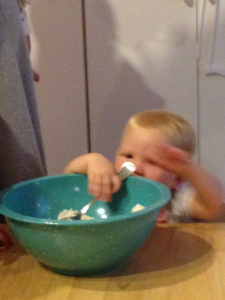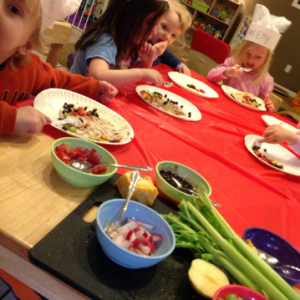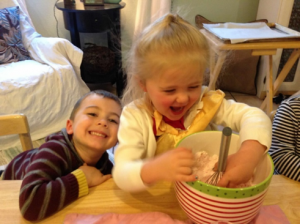Cooking Up Mathematical Fun
Research indicates that when children enter kindergarten, math skills are one of the leading indicators of their future academic success. “Early math skills are important predictors of later success in school in both reading and math.” (Duncan, et al., 2017). Therefore, the importance of creating math opportunities in early childhood is crucial. Because math is often seen as mainly a technical process, the fun starts when we can create math experiences that are enjoyable and meaningful at the same time. Culinary art requires a variety of math skills as well as providing a sense of purpose, self-expression, and artistic creativity. Cooking is fun. It helps children think of math in exciting ways not commonly presented to them. Because cooking is a tactile and sensory experience, children’s ideas can be easily incorporated. Cooking can inspire even young children while at the same time they are learning math. With a little organization and planning, children of every age can become involved in the kitchen and learn culinary skills that can be utilized all their lives. 
Bringing children into the kitchen is a magical way to combine process art with self-expression and introduce mathematical thinking. When cooking activities are well organized, children will enjoy directing their own learning. Allow plenty of time for wonder and excitement. Helping children learn the process of cooking through meaningful conversation helps them learn more about their experiences. Because cooking requires periods of one child doing a task while others watch, keeping the conversation going helps to alleviate the frustration when waiting and taking turns. With a little preparation and thoughtfulness, children will be involved in the full experience of culinary art. By working together, children can make delicious meals that not only nourish others but also create excitement about their role in the process. 
Cooking is a great opportunity to use a variety of mathematical vocabulary. Words like more, less, add, subtract, and the concept of time are all prevalent in the kitchen. Creating recipes requires print recognition, counting, measuring, estimating, learning patience, and developing language skills. Doubling recipes involves multiplication, measuring requires fractions, and eating cookies is subtraction at work. Younger children can pour ingredients in the bowl, help stir, rinse dishes, or scrub vegetables. Older children can calculate, measure, crack eggs, or monitor the timer. What can be more fun for everyone than counting out the chocolate chips? Games can be created by having children estimate to see who comes up with the correct answer. Building mathematical skills through cooking not only gives children confidence in their developing math skills but it also encourages them to work with others in a creative process.
One young chef in my program has been cooking at home since he was able to stand on a stool at his mom’s kitchen counter. It was difficult for him to hide his enthusiasm as he shared his mashing and mixing skills with his friends. He was able to recall memories of his family cooking experiences just through our activity at school. Other children are just being introduced to the variety of ways math is used in the kitchen. The excitement builds as children’s interest increases, new concepts are learned, and experiences are shared. Cooking together can be a meaningful way to strengthen relationships, learn mathematical vocabulary, and understand the value of math in creative activities. Children learn how math is necessary in the kitchen while experiencing the exciting outcome of edible art.
As we scaffold children’s experiences from their prior knowledge, we learn what they can do and then find appropriate kitchen tasks to challenge them. As educators, we never know how a child’s learning experience will inspire and impact their lives in later years.  Perhaps we are making cookies today with the future executive chefs of tomorrow.
Perhaps we are making cookies today with the future executive chefs of tomorrow.
cooking is a great way to help children with math sorting dry and wet ingredients, how many different ingredients we used, how many of us cooking and the finished product
I agree we work together to make a hotdog casserole that my daycare children love we use so much math with who is attendance that day to how many hot dogs and buns needed to measuring the cheese needed and who has the most assignment to do.
Vickie Whitesell
Cooking with children and using math is fun and gives children an experiences with measurements, building math vocabulary and self confidence.
Cooking with children and using math is fun and gives children an experiences with measurements, building math vocabulary and self confidence. Making pizza and following the steps 1st, 2nd and 3rd help them follow sequential order.
Cooking is a great way for the children to sort, dry and wet ingredients.
Cooking is a favorite activity for children to measure and count. They are having fun while learning and as they get older they can also measure using 1/4 tsp.
i agree cooking should be apart of routine lessons that make math engaging.
I agree with this! My now nine year old cooked together quite a bit and she also did with her grandma and still does! She reads how much of what you need and can pretty much run it by her self! We made from scratch sugar cookies and lets just say she definitely has it down. She is also a wiz at math in school it is her favorite subject and she uses skills learned from cooking.
Understanding the value of math in edible art helps children think mathematically about what they are doing.
Love to use cooking as part of my math lessons
cooking is a great way to use measurement and counting. we start by selecting something that we would cook for lunch and prepare it an hour before. we also enjoy setting the table and counting how many cups, forks, plates and napkins we will need to use.
I love how cooking connects the math concept of measuring with something that is so natural for most kids and provides such hands on experiences.
I do two cooking experiences monthly with the children in my program. I’m excited to teach these lessons with more math emphasis.
This is an excellent way to help children with data collection. You can set up the ingredients and have them put them into categories based on what they are or what they like to eat. Then make chart based on how many children like or dislike what’s on the board.